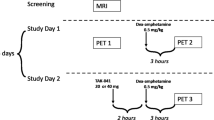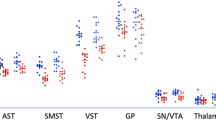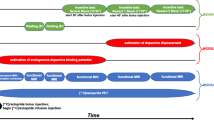Abstract
Imaging the competition between D2/3 radioligands and endogenous dopamine is so far the only way to measure dopamine release in the living human brain. The dopamine D2 receptor exists in a high (D2high) and a low-affinity state for dopamine. Under physiological conditions, dopamine is expected to bind to D2high only. [11C]-(+)-4-propyl-9-hydroxynaphthoxazine ((+)-PHNO) is the first D2/3 agonist radioligand for positron emission tomography (PET) imaging in humans. Since [11C]-(+)-PHNO is expected to bind preferentially to D2high, it should be particularly vulnerable to competition with endogenous dopamine. Nine healthy subjects participated in two PET scans, one after administration of d-amphetamine and one after placebo. [11C]-(+)-PHNO PET test re-test variability was determined in 11 healthy subjects. Binding potentials (BPs) were calculated for caudate, putamen, ventral striatum, and globus pallidus. d-Amphetamine led to a significant decrease of [11C]-(+)-PHNO BPs in caudate (−13.2%), putamen (−20.8%), and ventral striatum (−24.9%), but not in globus pallidus (−6.5%). d-Amphetamine-induced displacement correlated with serum d-amphetamine levels in all regions but caudate. This is the first report on competition between endogenous dopamine and a D2/3 agonist radioligand in humans. [11C]-(+)-PHNO PET might be a superior measure for release of endogenous dopamine than PET employing conventional D2/3 antagonist radioligands.
Similar content being viewed by others
Log in or create a free account to read this content
Gain free access to this article, as well as selected content from this journal and more on nature.com
or
References
Abi-Dargham A, Gil R, Krystal J, Baldwin RM, Seibyl JP, Bowers M et al (1998). Increased striatal dopamine transmission in schizophrenia: confirmation in a second cohort. Am J Psychiatry 155: 761–767.
Breier A, Su TP, Saunders R, Carson RE, Kolachana BS, de Bartolomeis A et al (1997). Schizophrenia is associated with elevated amphetamine-induced synaptic dopamine concentrations: evidence from a novel positron emission tomography method. Proc Natl Acad Sci USA 94: 2569–2574.
Brown DJ, Luthra SK, Brady F, Prenant C, Dijkstra D, Wikström H et al (1997). Labeling of the D2 agonist -(+)-PHNO using [11C]-propionyl chloride. XIIth International Symposium. Radiopharmaceutical Chemistry, Uppsala, Sweden. Wiley: Chichester, UK. pp 565–566.
Camps M, Cortes R, Gueye B, Probst A, Palacios JM (1989). Dopamine receptors in human brain: autoradiographic distribution of D2 sites. Neuroscience 28: 275–290.
Cardenas L, Houle S, Kapur S, Busto UE (2004). Oral D-amphetamine causes prolonged displacement of [11C]raclopride as measured by PET. Synapse 51: 27–31.
Carpenter DO (1990). Neural mechanisms of emesis. Can J Physiol Pharmacol 68: 230–236.
Coleman RJ, Quinn NP, Traub M, Marsden CD (1990). Nasogastric and intravenous infusions of (+)-4-propyl-9-hydroxynaphthoxazine (PHNO) in Parkinson's disease. J Neurol Neurosurg Psychiatry 53: 102–105.
Cumming P, Gillings NM, Jensen SB, Bjarkam C, Gjedde A (2003). Kinetics of the uptake and distribution of the dopamine D(2,3) agonist (R)-N-n-propylnorapomorphine in brain of healthy and MPTP-treated Gottingen miniature pigs. Nucl Med Biol 30: 547–553.
Cumming P, Wong DF, Dannals RF, Gillings N, Hilton J, Scheffel U et al (2002). The competition between endogenous dopamine and radioligands for specific binding to dopamine receptors. Ann N Y Acad Sci 965: 440–450.
de la Fuente-Fernandez R, Phillips AG, Zamburlini M, Sossi V, Calne DB, Ruth TJ et al (2002). Dopamine release in human ventral striatum and expectation of reward. Behav Brain Res 136: 359–363.
de la Fuente-Fernandez R, Sossi V, Huang Z, Furtado S, Lu JQ, Calne DB et al (2004). Levodopa-induced changes in synaptic dopamine levels increase with progression of Parkinson's disease: implications for dyskinesias. Brain 127: 2747–2754.
Di Chiara G (1999). Drug addiction as dopamine-dependent associative learning disorder. Eur J Pharmacol 375: 13–30.
Drevets WC, Gautier C, Price JC, Kupfer DJ, Kinahan PE, Grace AA et al (2001). Amphetamine-induced dopamine release in human ventral striatum correlates with euphoria. Biol Psychiatry 49: 81–96.
Farde L, Nordstrom AL, Wiesel FA, Pauli S, Halldin C, Sedvall G (1992). Positron emission tomographic analysis of central D1 and D2 dopamine receptor occupancy in patients treated with classical neuroleptics and clozapine. Relation to extrapyramidal side effects. Arch Gen Psychiatry 49: 538–544.
Finnema SJ, Seneca N, Farde L, Shchukin E, Sovago J, Gulyas B et al (2005). A preliminary PET evaluation of the new dopamine D2 receptor agonist [11C]MNPA in cynomolgus monkey. Nucl Med Biol 32: 353–360.
Freedman SB, Patel S, Marwood R, Emms F, Seabrook GR, Knowles MR et al (1994). Expression and pharmacological characterization of the human D3 dopamine receptor. J Pharmacol Exp Ther 268: 417–426.
Galineau L, Wilson AA, Garcia A, Houle S, Kapur S, Ginovart N (2006). In vivo characterization of the pharmacokinetics and pharmacological properties of [11C]-(+)-PHNO in rats using an intracerebral beta-sensitive system. Synapse 60: 172–183.
George SR, Watanabe M, Di Paolo T, Falardeau P, Labrie F, Seeman P (1985). The functional state of the dopamine receptor in the anterior pituitary is in the high affinity form. Endocrinology 117: 690–697.
Ginovart N (2005). Imaging the dopamine system with in vivo [11C]raclopride displacement studies: understanding the true mechanism. Mol Imaging Biol 7: 45–52.
Ginovart N, Galineau L, Willeit M, Mizrahi R, Bloomfield PM, Seeman P et al (2006a). Binding characteristics and sensitivity to endogenous dopamine of [11C]-(+)-PHNO, a new agonist radiotracer for imaging the high-affinity state of D2 receptors in vivo using positron emission tomography. J Neurochem 97: 1089–1103.
Ginovart N, Willeit M, Rusjan PM, Graff A, Bloomfield PM, Houle S et al (2006b). Positron emission tomography quantification of [11C]-(+)-PHNO binding in the human brain. J Cereb Blood Flow Metabo [E-pub ahead of print] doi:10.1038/sj.jcbfm.9600411.
Ginovart N, Wilson AA, Houle S, Kapur S (2004). Amphetamine pretreatment induces a change in both D2-Receptor density and apparent affinity: a [11C]raclopride positron emission tomography study in cats. Biol Psychiatry 55: 1188–1194.
Grandas F, Quinn N, Critchley P, Rohan A, Marsden CD, Stahl SM (1987). Antiparkinsonian activity of a single oral dose of PHNO. Mov Disord 2: 47–51.
Gurevich EV, Joyce JN (1999). Distribution of dopamine D3 receptor expressing neurons in the human forebrain: comparison with D2 receptor expressing neurons. Neuropsychopharmacology 20: 60–80.
Hall H, Halldin C, Dijkstra D, Wikstrom H, Wise LD, Pugsley TA et al (1996). Autoradiographic localisation of D3-dopamine receptors in the human brain using the selective D3-dopamine receptor agonist (+)-PD 128907. Psychopharmacology (Berlin) 128: 240–247.
Hume SP, Gunn RN, Jones T (1998). Pharmacological constraints associated with positron emission tomographic scanning of small laboratory animals. Eur J Nucl Med 25: 173–176.
Hwang DR, Kegeles LS, Laruelle M (2000). N-[(11)C]propyl-norapomorphine: a positron-labeled dopamine agonist for PET imaging of D(2) receptors. Nucl Med Biol 27: 533–539.
Justice AJ, de Wit H (2000). Acute effects of estradiol pretreatment on the response to d-amphetamine in women. Neuroendocrinology 71: 51–59.
Kiyatkin EA, Brown PL (2003). Fluctuations in neural activity during cocaine self-administration: clues provided by brain thermorecording. Neuroscience 116: 525–538.
Koepp MJ, Gunn RN, Lawrence AD, Cunningham VJ, Dagher A, Jones T et al (1998). Evidence for striatal dopamine release during a video game. Nature 393: 266–268.
Lammertsma AA, Bench CJ, Hume SP, Osman S, Gunn K, Brooks DJ et al (1996). Comparison of methods for analysis of clinical [11C]raclopride studies. J Cereb Blood Flow Metab 16: 42–52.
Laruelle M (2000). Imaging synaptic neurotransmission with in vivo binding competition techniques: a critical review. J Cereb Blood Flow Metab 20: 423–451.
Laruelle M, Abi-Dargham A, Gil R, Kegeles L, Innis R (1999). Increased dopamine transmission in schizophrenia: relationship to illness phases. Biol Psychiatry 46: 56–72.
Laruelle M, Abi-Dargham A, van Dyck CH, Gil R, D'Souza CD, Erdos J et al (1996). Single photon emission computerized tomography imaging of amphetamine-induced dopamine release in drug-free schizophrenic subjects. Proc Natl Acad Sci USA 93: 9235–9240.
Laruelle M, Abi-Dargham A, van Dyck CH, Rosenblatt W, Zea-Ponce Y, Zoghbi SS et al (1995). SPECT imaging of striatal dopamine release after amphetamine challenge. J Nucl Med 36: 1182–1190.
Laruelle M, D'Souza CD, Baldwin RM, Abi-Dargham A, Kanes SJ, Fingado CL et al (1997). Imaging D2 receptor occupancy by endogenous dopamine in humans. Neuropsychopharmacology 17: 162–174.
Leff P (1995). The two-state model of receptor activation. Trends Pharmacol Sci 16: 89–97.
Levant B (1998). Differential distribution of D3 dopamine receptors in the brains of several mammalian species. Brain Res 800: 269–274.
Leyton M, Boileau I, Benkelfat C, Diksic M, Baker G, Dagher A (2002). Amphetamine-induced increases in extracellular dopamine, drug wanting, and novelty seeking: a PET/[11C]raclopride study in healthy men. Neuropsychopharmacology 27: 1027–1035.
Martin GE, Williams M, Pettibone DJ, Yarbrough GG, Clineschmidt BV, Jones JH (1984). Pharmacologic profile of a novel potent direct-acting dopamine agonist, (+)-4-propyl-9-hydroxynaphthoxazine [(+)-PHNO]. J Pharmacol Exp Ther 230: 569–576.
Martinez D, Gil R, Slifstein M, Hwang DR, Huang Y, Perez A et al (2005). Alcohol dependence is associated with blunted dopamine transmission in the ventral striatum. Biol Psychiatry 58: 779–786.
Mawlawi O, Martinez D, Slifstein M, Broft A, Chatterjee R, Hwang DR et al (2001). Imaging human mesolimbic dopamine transmission with positron emission tomography: I. Accuracy and precision of D(2) receptor parameter measurements in ventral striatum. J Cereb Blood Flow Metab 21: 1034–1057.
McCormick P, Ginovart N, Vasdev N, Seeman P, Kapur S, Wilson AA (2006). Isoflurane increases both the specific binding ratio and sensitivity to amphetamine challenge of [11C]-(+)-PHNO. Neuroimage 31: T33.
Meller E, Puza T, Miller JC, Friedhoff AJ, Schweitzer JW (1991). Receptor reserve for D2 dopaminergic inhibition of prolactin release in vivo and in vitro. J Pharmacol Exp Ther 257: 668–675.
Mukherjee J, Narayanan TK, Christian BT, Shi B, Dunigan KA, Mantil J (2000). In vitro and in vivo evaluation of the binding of the dopamine D2 receptor agonist (11)C-(R,S)-5-hydroxy-2-(di-n-propylamino)tetralin in rodents and nonhuman primate. Synapse 37: 64–70.
Mukherjee J, Narayanan TK, Christian BT, Shi B, Yang ZY (2004). Binding characteristics of high-affinity dopamine D2/D3 receptor agonists, 11C-PPHT and 11C-ZYY-339 in rodents and imaging in non-human primates by PET. Synapse 54: 83–91.
Munro CA, McCaul ME, Wong DF, Oswald LM, Zhou Y, Brasic J et al (2006). Sex differences in striatal dopamine release in healthy adults. Biol Psychiatry 59: 966–974.
Murray AM, Ryoo HL, Gurevich E, Joyce JN (1994). Localization of dopamine D3 receptors to mesolimbic and D2 receptors to mesostriatal regions of human forebrain. Proc Natl Acad Sci USA 91: 11271–11275.
Narendran R, Hwang DR, Slifstein M, Talbot PS, Erritzoe D, Huang Y et al (2004). In vivo vulnerability to competition by endogenous dopamine: comparison of the D2 receptor agonist radiotracer (−)-N-[11C]propyl-norapomorphine ([11C]NPA) with the D2 receptor antagonist radiotracer [11C]-raclopride. Synapse 52: 188–208.
Narendran R, Slifstein M, Guillin O, Hwang Y, Hwang DR, Scher E et al (2006). Dopamine (D2/3) receptor agonist positron emission tomography radiotracer [(11)C]-(+)-PHNO is a D(3) receptor preferring agonist in vivo. Synapse 60: 485–495.
Nomoto M, Stahl S, Jenner P, Marsden CD (1987). Antiparkinsonian activity of (+)-PHNO in the MPTP-treated common marmoset. Mov Disord 2: 37–45.
Nordström A_L, Farde L, Pauli S, Litton J-E, Halldin C (1992). PET analysis of central [11C]raclopride binding in healthy young adults and schizophrenic patients—reliability and age effects. Hum Psychopharmacol 7: 157–165.
Oswald LM, Wong DF, McCaul M, Zhou Y, Kuwabara H, Choi L et al (2005). Relationships among ventral striatal dopamine release, cortisol secretion, and subjective responses to amphetamine. Neuropsychopharmacology 30: 821–832.
Pruessner JC, Champagne F, Meaney MJ, Dagher A (2004). Dopamine release in response to a psychological stress in humans and its relationship to early life maternal care: a positron emission tomography study using [11C]raclopride. J Neurosci 24: 2825–2831.
Riccardi P, Li R, Ansari MS, Zald D, Park S, Dawant B et al (2006). Amphetamine-induced displacement of [18F] fallypride in striatum and extrastriatal regions in humans. Neuropsychopharmacology 31: 1016–1026.
Rusjan P, Mamo D, Ginovart N, Hussey D, Vitcu I, Yasuno F et al (2006a). An automated method for the extraction of regional data from PET images. Psychiatry Res 147: 79–89.
Rusjan PM, Mizrahi R, Ginovart N, Graff A, Willeit M, Vitcu I et al (2006b). Validation of a method for automatic quantification of radioactivity in the globus pallidus in [11C]-(+)-PHNO PET images. Neuroimage 31: T96.
Seeman P, Ko F, Willeit M, McCormick P, Ginovart N (2005). Antiparkinson concentrations of pramipexole and PHNO occupy dopamine D2(high) and D3(high) receptors. Synapse 58: 122–128.
Seeman P, Wilson A, Gmeiner P, Kapur S (2006). Dopamine D2 and D3 receptors in human putamen, caudate nucleus, and globus pallidus. Synapse 60: 205–211.
Sellings LH, McQuade LE, Clarke PB (2006). Characterization of dopamine-dependent rewarding and locomotor stimulant effects of intravenously-administered methylphenidate in rats. Neuroscience 14: 1457–1468.
Seneca N, Finnema SJ, Farde L, Gulyas B, Wikstrom HV, Halldin C et al (2006). Effect of amphetamine on dopamine D2 receptor binding in nonhuman primate brain: a comparison of the agonist radioligand [11C]MNPA and antagonist [11C]raclopride. Synapse 59: 260–269.
Sheehan DV, Lecrubier Y, Sheehan KH, Amorim P, Janavs J, Weiller E et al (1998). The Mini-International Neuropsychiatric Interview (MINI): the development and validation of a structured diagnostic psychiatric interview for DSM-IV and ICD-10. J Clin Psychiatry 59 (Suppl 20): 22–33; quiz 34–57.
Shi B, Narayanan TK, Christian BT, Chattopadhyay S, Mukherjee J (2004). Synthesis and biological evaluation of the binding of dopamine D2/D3 receptor agonist, (R,S)-5-hydroxy-2-(N-propyl-N-(5′-(18)F-fluoropentyl)aminotetralin ((18)F-5-OH-FPPAT) in rodents and nonhuman primates. Nucl Med Biol 31: 303–311.
Shi B, Narayanan TK, Yang ZY, Christian BT, Mukherjee J (1999). Radiosynthesis and in vitro evaluation of 2-(N-alkyl-N-1′-11C-propyl)amino-5-hydroxytetralin analogs as high affinity agonists for dopamine D-2 receptors. Nucl Med Biol 26: 725–735.
Sibley DR, De Lean A, Creese I (1982). Anterior pituitary dopamine receptors. Demonstration of interconvertible high and low affinity states of the D-2 dopamine receptor. J Biol Chem 257: 6351–6361.
Spinks R, Nopoulos P, Ward J, Fuller R, Magnotta VA, Andreasen NC (2005). Globus pallidus volume is related to symptom severity in neuroleptic naive patients with schizophrenia. Schizophr Res 73: 229–233.
Sun W, Ginovart N, Ko F, Seeman P, Kapur S (2003). In vivo evidence for dopamine-mediated internalization of D2-receptors after amphetamine: differential findings with raclopride versus spiperone. Mol Pharmacol 63: 456–462.
Tedroff J, Pedersen M, Aquilonius SM, Hartvig P, Jacobsson G, Langstrom B (1996). Levodopa-induced changes in synaptic dopamine in patients with Parkinson's disease as measured by [11C]raclopride displacement and PET. Neurology 46: 1430–1436.
Volkow ND, Wang GJ, Fowler JS, Logan J, Schlyer D, Hitzemann R et al (1994). Imaging endogenous dopamine competition with [11C]raclopride in the human brain. Synapse 16: 255–262.
Volkow ND, Wang GJ, Telang F, Fowler JS, Logan J, Childress AR et al (2006). Cocaine cues and dopamine in dorsal striatum: mechanism of craving in cocaine addiction. J Neurosci 26: 6583–6588.
White TL, Justice AJ, de Wit H (2002). Differential subjective effects of D-amphetamine by gender, hormone levels and menstrual cycle phase. Pharmacol Biochem Behav 73: 729–741.
Willeit M, Ginovart N, Kapur S, Houle S, Hussey D, Seeman P et al (2006). High-affinity states of human brain dopamine D2/3 receptors imaged by the agonist [11C]-(+)-PHNO. Biol Psychiatry 59: 389–394.
Wilson AA, McCormick P, Kapur S, Willeit M, Garcia A, Hussey D et al (2005). Radiosynthesis and evaluation of [11C]-(+)-4-propyl-3,4,4a,5,6,10b-hexahydro-2H-naphthooxazin-9 -ol as a potential radiotracer for in vivo imaging of the dopamine D2 high-affinity state with positron emission tomography. J Med Chem 48: 4153–4160.
Wise RA (2004). Dopamine, learning and motivation. Nat Rev Neurosci 5: 483–494.
Zahniser NR, Molinoff PB (1978). Effect of guanine nucleotides on striatal dopamine receptors. Nature 275: 453–455.
Zald DH, Boileau I, El-Dearedy W, Gunn R, McGlone F, Dichter GS et al (2004). Dopamine transmission in the human striatum during monetary reward tasks. J Neurosci 24: 4105–4112.
Zijlstra S, van der Worp H, Wiegman T, Visser GM, Korf J, Vaalburg W (1993a). Synthesis and in vivo distribution in the rat of a dopamine agonist: N-([11C]methyl)norapomorphine. Nucl Med Biol 20: 7–12.
Zijlstra S, Visser GM, Korf J, Vaalburg W (1993b). Synthesis and in vivo distribution in the rat of several fluorine-18 labeled N-fluoroalkylaporphines. Appl Radiat Isot 44: 651–658.
Acknowledgements
This work was supported in part by the Canadian Institutes for Health Research (Grant #74702 to AAW). Funding of the PET camera system CPS-HRRT was supported by the Canada Foundation for Innovation, the Ontario Innovation Trust and the Ontario Research and Development Challenge Fund. SK was supported by a CRC Chair in Schizophrenia and Therapeutic Neuroscience. We thank Penny Barsoum, Anna Carella, Armando Garcia, Doug Hussey, Alvina Ng, Nicole Praschak-Rieder, CM Shammi, and Winston Stableford for their indispensable technical and logistic assistance, and Peter Bloomfield for physics support. We also thank Laurie Zawertailo and Usoa Busto for their intellectual input during planning of this study. This work was presented in part at the meeting of the Society of Biological Psychiatry, 2006, Toronto, ON.
Author information
Authors and Affiliations
Corresponding author
Rights and permissions
About this article
Cite this article
Willeit, M., Ginovart, N., Graff, A. et al. First Human Evidence of d-Amphetamine Induced Displacement of a D2/3 Agonist Radioligand: A [11C]-(+)-PHNO Positron Emission Tomography Study. Neuropsychopharmacol 33, 279–289 (2008). https://doi.org/10.1038/sj.npp.1301400
Received:
Revised:
Accepted:
Published:
Issue date:
DOI: https://doi.org/10.1038/sj.npp.1301400
Keywords
This article is cited by
-
Effect of scan-time shortening on the 11C-PHNO binding potential to dopamine D3 receptor in humans and test–retest reliability
Annals of Nuclear Medicine (2023)
-
The relationship between glutamate, dopamine, and cortical gray matter: A simultaneous PET-MR study
Molecular Psychiatry (2022)
-
EANM guideline for harmonisation on molar activity or specific activity of radiopharmaceuticals: impact on safety and imaging quality
EJNMMI Radiopharmacy and Chemistry (2021)
-
The influence of conditioned stimuli on [11C]-(+)-PHNO PET binding in tobacco smokers after a one week abstinence
Scientific Reports (2021)
-
D3 dopamine receptors and a missense mutation of fatty acid amide hydrolase linked in mouse and men: implication for addiction
Neuropsychopharmacology (2020)



